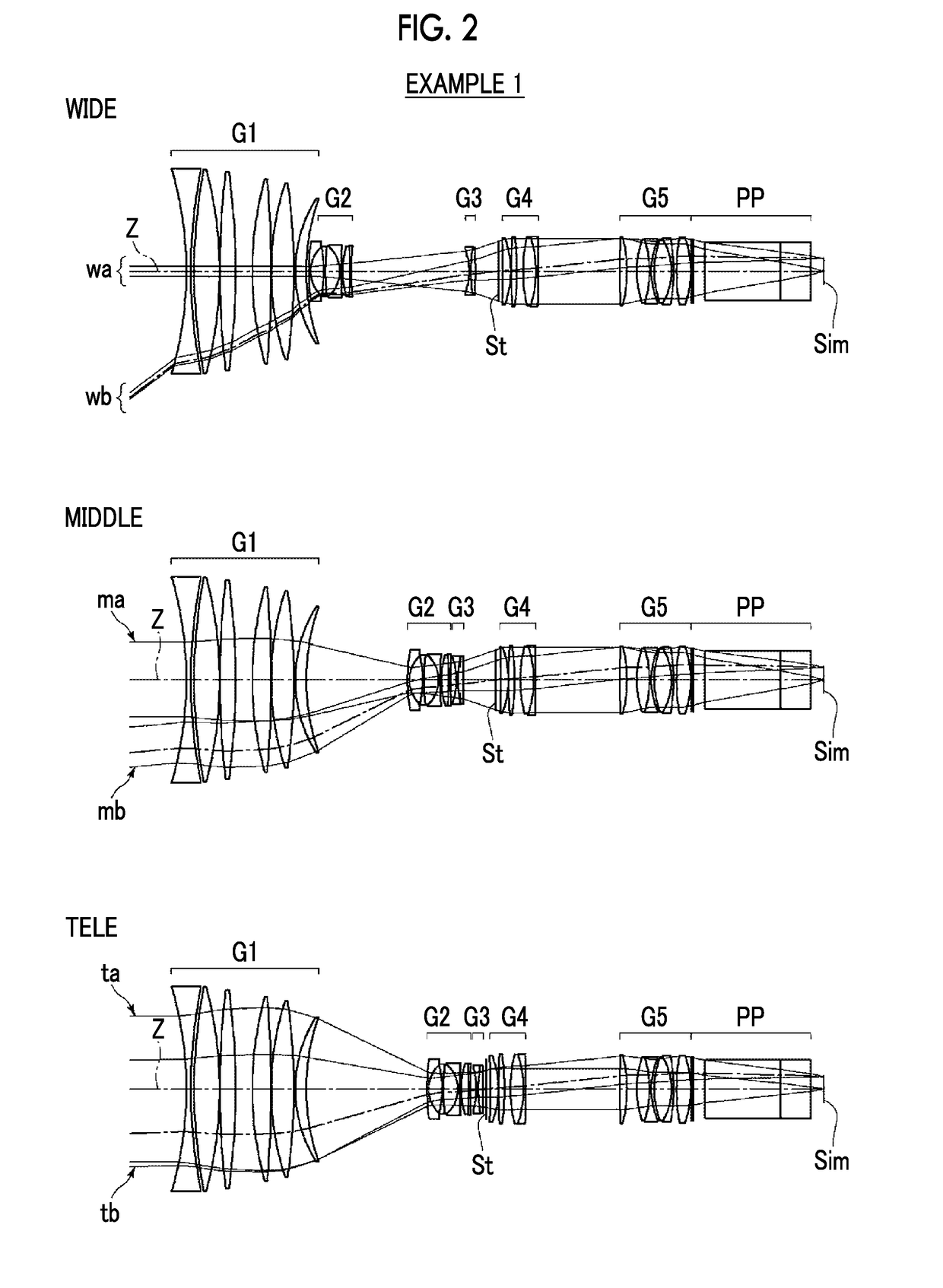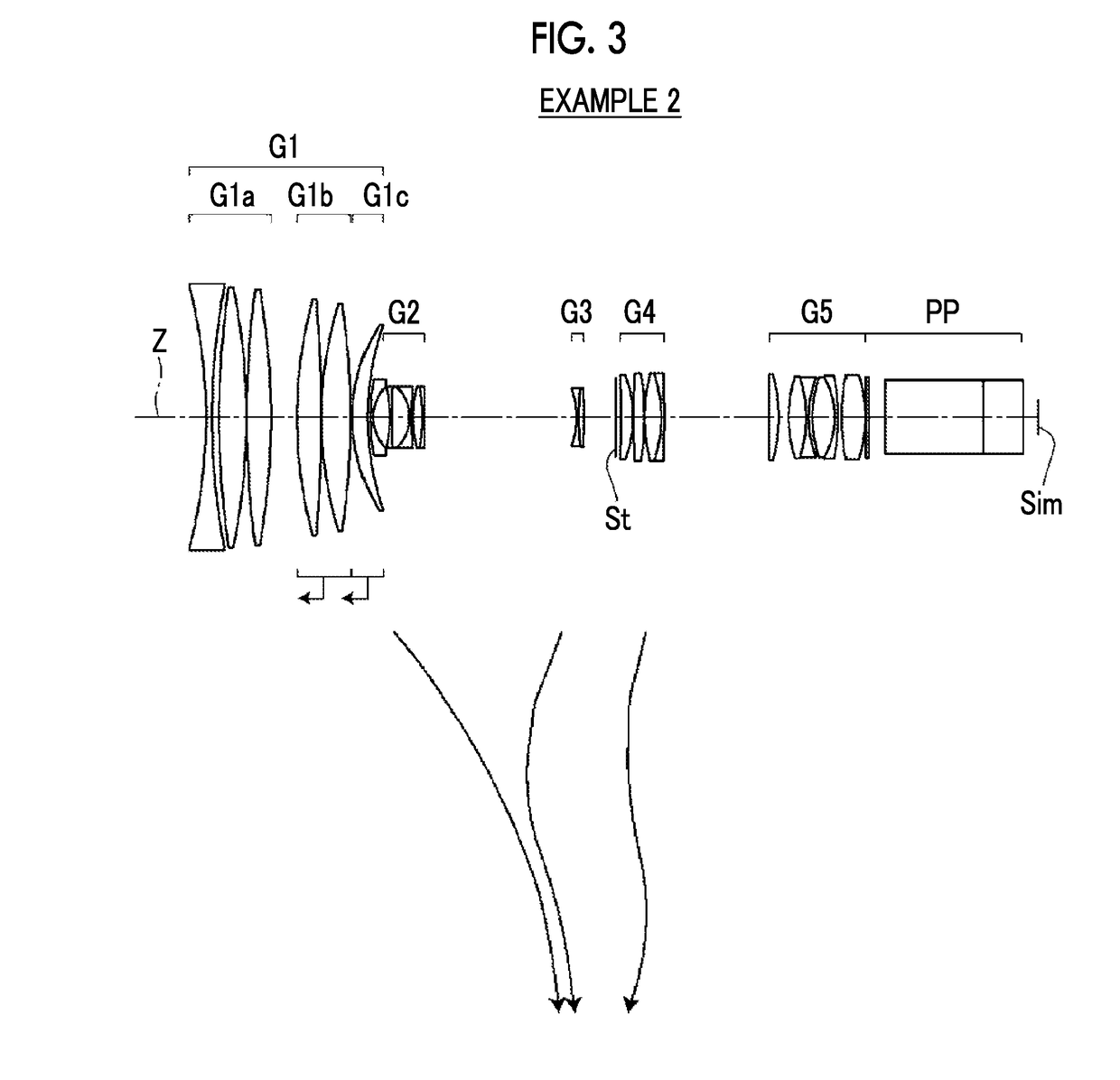Zoom lens and imaging apparatus
- Summary
- Abstract
- Description
- Claims
- Application Information
AI Technical Summary
Benefits of technology
Problems solved by technology
Method used
Image
Examples
example 1
[0063]FIGS. 1 and 2 are cross-sectional views of a zoom lens of Example 1, and an illustration method thereof is as described above. Therefore, repeated description is partially omitted herein. The zoom lens of Example 1 consists of, in order from the object side to the image side, a first lens group G1 having a positive refractive power, a second lens group G2 having a negative refractive power, a third lens group G3 having a negative refractive power, an aperture stop St, a fourth lens group G4 having a positive refractive power, and a fifth lens group G5 having a positive refractive power. During zooming, the first lens group G1 and the fifth lens group G5 remain stationary with respect to the image plane Sim, the other lens groups move such that distances between lens groups adjacent to each other in the direction of the optical axis change, and the aperture stop St moves integrally with the fourth lens group G4. The first lens group G1 consists of, in order from the object side...
example 2
[0076]FIG. 3 is a cross-sectional view of a zoom lens of Example 2. The zoom lens of Example 2 has the same configuration as the outline of the zoom lens of Example 1. Table 4 shows basic lens data of the zoom lens of Example 2, Table 5 shows specification and variable surface distances, Table 6 shows aspheric surface coefficients, and FIG. 8 shows aberration diagrams in a state where the object at infinity is in focus.
TABLE 4Example 2SurfaceNumberRDNdνdθgF 1−174.78582.00001.8502632.350.59472 2227.30242.4601 3300.06799.09081.4338795.180.53733 4−212.93190.1200 5325.50498.16381.4370095.100.53364*6−220.62888.6400 7148.89078.11401.4338795.180.53733 8−476.77200.1200 9129.70699.69331.4370095.100.5336410−254.74770.60001158.34914.87171.7638548.490.558981294.5804DD[12]*13 76.04390.90002.0509026.940.605191414.61775.470315−46.84890.74501.8160046.620.5568216144.72096.00611.8589622.730.6284417−13.71560.73491.9537532.320.5901518290.50420.34261938.27543.01761.7847225.680.6162120−79.84570.74481.772...
example 3
[0077]FIG. 4 is a cross-sectional view of a zoom lens of Example 3. The zoom lens of Example 3 has the same configuration as the outline of the zoom lens of Example 1. Table 7 shows basic lens data of the zoom lens of Example 3, Table 8 shows specification and variable surface distances, Table 9 shows aspheric surface coefficients, and FIG. 9 shows aberration diagrams in a state where the object at infinity is in focus.
TABLE 7Example 3SurfaceNumberRDNdνdθgF 1−147.12362.00001.8061033.270.58845 2278.50482.1521 3387.42889.48801.4338795.180.53733 4−167.98110.1198 5554.36757.02911.4387594.660.53402*6−218.11457.2300 7155.42938.11721.4338795.180.53733 8−430.43860.1198 9128.88539.39861.4970081.540.5374810−298.33010.66001155.68365.12331.6956059.050.543481289.3508DD[12]*13 75.94430.90002.0010029.130.599521414.39916.083215−44.76520.74481.7725049.600.5521216284.34225.87251.8466623.780.6192317−14.46960.74041.9537532.320.5901518488.01630.17931937.14434.07391.7847225.680.6162120−46.76040.74561.788...
PUM
 Login to View More
Login to View More Abstract
Description
Claims
Application Information
 Login to View More
Login to View More - R&D
- Intellectual Property
- Life Sciences
- Materials
- Tech Scout
- Unparalleled Data Quality
- Higher Quality Content
- 60% Fewer Hallucinations
Browse by: Latest US Patents, China's latest patents, Technical Efficacy Thesaurus, Application Domain, Technology Topic, Popular Technical Reports.
© 2025 PatSnap. All rights reserved.Legal|Privacy policy|Modern Slavery Act Transparency Statement|Sitemap|About US| Contact US: help@patsnap.com



